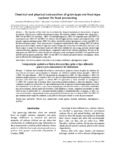Use este identificador para citar ou linkar para este item:
http://www.alice.cnptia.embrapa.br/alice/handle/doc/471528Registro completo de metadados
| Campo DC | Valor | Idioma |
|---|---|---|
| dc.contributor.author | SILVA, J. B. da | pt_BR |
| dc.contributor.author | CARRÃO-PANIZZI, M. C. | pt_BR |
| dc.contributor.author | PRUDÊNCIO, S. H. | pt_BR |
| dc.date.accessioned | 2011-04-10T11:11:11Z | pt_BR |
| dc.date.available | 2011-04-10T11:11:11Z | pt_BR |
| dc.date.created | 2009-09-17 | pt_BR |
| dc.date.issued | 2009 | pt_BR |
| dc.identifier.citation | Pesquisa Agropecuária Brasileira, Brasília, DF, v. 44, n. 7, p. 777-784, jul. 2009. | pt_BR |
| dc.identifier.uri | http://www.alice.cnptia.embrapa.br/alice/handle/doc/471528 | pt_BR |
| dc.description | The objective of this work was to evaluate the chemical and physical characteristics of grains of soybean (Glycine max) cultivars for food processing. The soybean cultivars evaluated were: grain-type - BRS 133 and BRS 258; food-type - BRS 213 (null lipoxygenases), BRS 267 (vegetable-type) and BRS 216 (small grain size). BRS 267 and BRS 216 cultivars showed higher protein content, indicating that they could promote superior nutritional value. BRS 213 cultivar showed the lowest lipoxygenase activity, and BRS 267, the lowest hexanal content. These characteristics can improve soyfood flavor. After cooking, BRS 267 cultivar grains presented a higher content of aglycones (more biologically active form of isoflavones) and oleic acid, which makes it proper for functional foods and with better stability for processing, and also showed high content of fructose, glutamic acid and alanine, compounds related to the soybean mild flavor. Because of its large grain size, BRS 267 is suitable for tofu and edamame, while small-grain-sized BRS 216 is good for natto and for soybean sprouts production. BRS 216 and BRS 213 cultivars presented shorter cooking time, which may be effective for reducing processing costs. | pt_BR |
| dc.language.iso | eng | eng |
| dc.rights | openAccess | eng |
| dc.title | Chemical and physical composition of grain-type and food-type soybean for food processing . | pt_BR |
| dc.type | Artigo de periódico | pt_BR |
| dc.date.updated | 2017-10-31T11:11:11Z | pt_BR |
| dc.subject.thesagro | Ácido Graxo | pt_BR |
| dc.subject.thesagro | Aminoácido | pt_BR |
| dc.subject.thesagro | Grão | pt_BR |
| dc.subject.thesagro | Nutrição Humana | pt_BR |
| dc.subject.thesagro | Soja | pt_BR |
| dc.subject.thesagro | Tecnologia de Alimento | pt_BR |
| riaa.ainfo.id | 471528 | pt_BR |
| riaa.ainfo.lastupdate | 2017-10-31 -02:00:00 | pt_BR |
| dc.contributor.institution | JOSEMEYRE BONIFÁCIO DA SILVA, UEL; MERCEDES CONCORDIA CARRAO PANIZZI, CNPSo; SANDRA HELENA PRUDÊNCIO, UEL. | pt_BR |
| Aparece nas coleções: | Artigo em periódico indexado (CNPSO)  | |
Arquivos associados a este item:
| Arquivo | Descrição | Tamanho | Formato | |
|---|---|---|---|---|
| ID29733.pdf | 871,43 kB | Adobe PDF |  Visualizar/Abrir |









